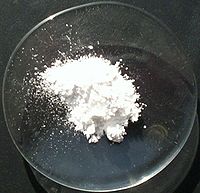Magnesium oxide
 |
|
 |
|
| Names | |
|---|---|
|
IUPAC name
Magnesium oxide
|
|
| Other names
Magnesia
Periclase |
|
| Identifiers | |
|
1309-48-4 |
|
| ChEMBL |
ChEMBL1200572 |
| ECHA InfoCard | 100.013.793 |
| EC Number | 215-171-9 |
| E number | E530 (acidity regulators, ...) |
| PubChem | 14792 |
| RTECS number | OM3850000 |
| Properties | |
| MgO | |
| Molar mass | 40.3044 g/mol |
| Appearance | White powder |
| Odor | Odorless |
| Density | 3.58 g/cm3 |
| Melting point | 2,852 °C (5,166 °F; 3,125 K) |
| Boiling point | 3,600 °C (6,510 °F; 3,870 K) |
| 0.00062 g/100 mL (0 °C) 0.0086 g/100 mL (30 °C) |
|
| Solubility | Soluble in acid, ammonia insoluble in alcohol |
| Band gap | 7.8 eV |
| −10.2·10−6 cm3/mol | |
| Thermal conductivity | 45–60 W·m−1·K−1 |
|
Refractive index (nD)
|
1.7355 |
| 6.2 ± 0.6 D | |
| Structure | |
| Halite (cubic), cF8 | |
| Fm3m, No. 225 | |
|
a = 4.212Å
|
|
| Octahedral (Mg2+); octahedral (O2−) | |
| Thermochemistry | |
| 37.8 J/mol K | |
|
Std molar
entropy (S |
26.9 J·mol−1·K−1 |
|
Std enthalpy of
formation (ΔfH |
−601.8 kJ·mol−1 |
|
Gibbs free energy (ΔfG˚)
|
-596.6 kJ/mol |
| Pharmacology | |
| A02AA02 (WHO) A06AD02 (WHO), A12CC10 (WHO) | |
| Hazards | |
| Main hazards | Metal fume fever, Irritant |
| Safety data sheet | ICSC 0504 |
| R-phrases | R36, R37, R38 |
| NFPA 704 | |
| Flash point | Non-flammable |
| US health exposure limits (NIOSH): | |
|
PEL (Permissible)
|
TWA 15 mg/m3 (fume) |
|
REL (Recommended)
|
None designated |
|
IDLH (Immediate danger)
|
750 mg/m3 (fume) |
| Related compounds | |
|
Other anions
|
Magnesium sulfide |
|
Other cations
|
Beryllium oxide Calcium oxide Strontium oxide Barium oxide |
|
Related compounds
|
Magnesium hydroxide Magnesium nitride |
|
Except where otherwise noted, data are given for materials in their standard state (at 25 °C [77 °F], 100 kPa).
|
|
|
|
|
| Infobox references | |
Magnesium oxide (MgO), or magnesia, is a white hygroscopic solid mineral that occurs naturally as periclase and is a source of magnesium (see also oxide). It has an empirical formula of MgO and consists of a lattice of Mg2+ ions and O2− ions held together by ionic bonding. Magnesium hydroxide forms in the presence of water (MgO + H2O → Mg(OH)2), but it can be reversed by heating it to separate moisture.
Magnesium oxide was historically known as magnesia alba (literally, the white mineral from magnesia - other sources give magnesia alba as MgCO3), to differentiate it from magnesia negra, a black mineral containing what is now known as manganese.
While "magnesium oxide" normally refers to MgO, magnesium peroxide MgO2 is also known as a compound. According to evolutionary crystal structure prediction, MgO2 is thermodynamically stable at pressures above 116 GPa (gigapascals), and a totally new semiconducting suboxide Mg3O2 is thermodynamically stable above 500 GPa. Because of its stability, MgO is used as a model system for investigating vibrational properties of crystals.
Magnesium oxide is produced by the calcination of magnesium carbonate or magnesium hydroxide. The latter is obtained by the treatment of magnesium chloride solutions, typically seawater, with lime.
Calcining at different temperatures produces magnesium oxide of different reactivity. High temperatures 1500 - 2000 °C diminish the available surface area and produces dead-burned (often called dead burnt) magnesia, an unreactive form used as a refractory. Calcining temperatures 1000 - 1500 °C produce hard-burned magnesia, which has limited reactivity and calcining at lower temperature, (700-1000 °C) produces light-burned magnesia, a reactive form, also known as caustic calcined magnesia. Although some decomposition of the carbonate to oxide occurs at temperatures below 700 °C, the resulting materials appears to reabsorption carbon dioxide from the air.
...
Wikipedia

